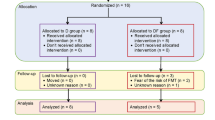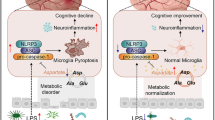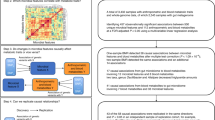Abstract
Fecal microbiota transplantation (FMT) has become an effective strategy to treat metabolic diseases, including type 2 diabetes mellitus (T2DM). We previously reported that the intestinal microbiome had significant difference between individuals with normal glucose tolerance and T2DM in Chinese Kazak ethnic group. In this study, we investigated the effects of transplanted fecal bacteria from Kazaks with normal glucose tolerance (KNGT) in db/db mice. The mice were treated with 0.2 mL of fecal bacteria solution from KNGT daily for 10 weeks. We showed that the fecal bacteria from KNGT successfully colonized in the intestinal tract of db/db mice detected on day 14. In the FMT-treated db/db mice, the levels of fasting blood glucose, postprandial glucose, total cholesterol, triglyceride, and low-density lipoprotein–cholesterol were significantly downregulated, whereas high-density lipoprotein–cholesterol levels were upregulated. In the FMT-treated db/db mice, Desulfovibrio and Clostridium coccoides levels in gut were significantly decreased, but the fecal levels of Akkermansia muciniphila and colon histone deacetylase-3 (HDAC3) protein expression were increased. At 8 weeks, both intestinal target bacteria and HDAC3 were correlated with glycolipid levels; Akkermansia muciniphila level was positively correlated with HDAC3 protein expression (r = +0.620, P = 0.037). Our results suggest that fecal bacteria from KNGT could potentially be used to treat diabetic patients.
Similar content being viewed by others
Log in or create a free account to read this content
Gain free access to this article, as well as selected content from this journal and more on nature.com
or
References
International Diabetes Federation. IDF diabetes atlas 2015. 7th edn. Brussels, Belgium: International Diabetes Federation; 2015.
Chinese Diabetes Society. Guidelines for the prevention and treatment of type 2 diabetes in china (2013 edition) (in Chinese). Chin J Endocrinol Metab. 2014;30:893–942.
Liljedahl L, Norlin J, McGuire JN, James P. Effects of insulin and the glucagon‐like peptide 1 receptor agonist liraglutide on the kidney proteome in db/db mice. Physiol Rep. 2017;5:e13187.
Wang Y, Luo X, Mao XM, Tao YC, Ran XJ, Zhao HX, et al. Gut microbiome analysis of type 2 diabetic patients from the Chinese minority ethnic groups the Uygurs and Kazaks. PLoS ONE. 2017;12:e0172774.
Hu SS. The function and mechanism of the key bacteria isolated from Kazaks and Uygurs in Xinjiang with type 2 diabetes leads to diabetes in mice [dissertation]. Urumqi (China): Xinjiang Med Univ; 2016. p.1–30.
Qin JJ, Li YR, Cai ZM, Li SH, Zhu JF, Zhang F, et al. A metagenome-wide association study of gut microbiota in type 2 diabetes. Nature. 2012;490:55–60.
Zhang KN, Long M, Ran XJ, Yang Y, Tong L, Li QC, et al. Effect of alcohol extract of coreopsis tinctoria nutt on intestinal flora in type 2 diabetic mice. Acta Lab Animalis Sci Sin. 2015;23:628–33.
Hartstra AV, Bouter KE, Backhed F, Nieuwdorp M. Insights into the role of the microbiome in obesity and type 2 diabetes. Diabetes Care. 2015;38:159–65.
Alenghat T, Osborne LC, Saenz SA, Kobuley D, Ziegler CGK, Mullican SE, et al. Histone deacetylase 3 coordinates commensal-bacteria-dependent intestinal homeostasis. Nature. 2013;504:153–7.
Lukovac S, Belzer C, Pellis L, Keijser BJ, de Vos WM, Montijn RC, et al. Differential modulation by Akkermansia muciniphila and Faecalibacterium prausnitzii of host peripheral lipid metabolism and histone acetylation in mouse gut organoids. Mbio. 2014;5:91–7.
Hong SG, Zhou WJ, Fang B, Lu WY, Loro E, Damle M, et al. Dissociation of muscle insulin sensitivity from exercise endurance in mice by HDAC3 depletion. Nat Med. 2016;23:223–34.
He CX, Shan YJ, Song W. Targeting gut microbiota as a possible therapy for diabetes. Nutr Res. 2015;35:361–7.
Groen AK, Nieuwdorp M. An evaluation of the therapeutic potential of fecal microbiota transplantation to treat infectious and metabolic diseases. EMBO Mol Med. 2017;9:1–3.
Shaukat A, Reinink AR. Fecal microbiota transplantation in Clostridium difficile infection: evidence and indications. Am Fam Physician. 2017;95:351–2.
Vrieze A, Van Nood E, Holleman F, Salojarvi J, Kootte RS, Bartelsman JF, et al. Transfer of intestinal microbiota from lean donors increases insulin sensitivity in individuals with metabolic syndrome. Gastroenterology. 2012;143:913–6.e7.
Association AD. Standards of medical care in diabetes. Diabetes Care. 2005;28(Suppl 1):S4–S36.
Chinese Diabetes Society. Recommendations for lower diagnostic cut-off point of impaired fasting glucose (in Chinese). Natl Med J Chin. 2005;85:1947–50.
Smits LP, Bouter KEC, De Vos WM, Borody TJ, Nieuwdorp M. Therapeutic potential of fecal microbiota transplantation. Gastroenterology. 2013;145:946–53.
Van Nood E, Vrieze A, Nieuwdorp M, Fuentes S, Zoetendal EG, De Vos WM, et al. Duodenal infusion of donor feces for recurrent Clostridium difficile. N Engl J Med. 2013;368:407–15.
Bakken JS, Borody T, Brandt LJ, Brill JV, Demarco DC, Franzos MA, et al. Treating Clostridium difficile infection with fecal microbiota transplantation. Clin Gastroenterol Hepatol. 2011;9:1044–9.
Cammarota G, Ianiro G, Tilg H, Rajilic-Stojanovic M, Kump P, Satokari R, et al. European consensus conference on faecal microbiota transplantation in clinical practice. Gut. 2017;66:569–80.
Zhang FM, Long CY, Li P. The holistic integrative view on the system of fecal microbiota transplantation (in Chinese). Chin Bull Life Sci. 2017;29:2–9.
Obesity S. Obesity: preventing and managing the global epidemic. Report of a WHO consultation. World Health Organ Tech Rep Ser. 2000;894:1–253.
Hamilton MJ, Weingarden AR, Sadowsky MJ, Khoruts A. Standardized frozen preparation for transplantation of fecal microbiota for recurrent Clostridium difficile infection. Am J Gastroenterol. 2012;107:761–7.
Feng YQ, Wang DC, Wang K, Leng XF, Xiao H, Guo DF. Role of lymphatics in bacterial translocation from intestine in burn rats. Zhonghua Shao Shang Za Zhi. 2011;27:49–53.
Lott JA, Turner K. Evaluation of Trinder’s glucose oxidase method for measuring glucose in serum and urine. Clin Chem. 1975;21:1754–60.
Claesson MJ, O’Sullivan O, Wang Q, Nikkilä J, Marchesi JR, Smidt H, et al. Comparative analysis of pyrosequencing and a phylogenetic microarray for exploring microbial community structures in the human distal intestine. PLoS ONE. 2009;4:e6669.
Zhao LP, Shen J. Whole-body systems approaches for gut microbiota-targeted, preventive healthcare. J Biotechnol. 2010;149:183–90.
Tao YC, Mao XM, Xie ZJ, Ran XJ, Liu XY, Wang Y, et al. The prevalence of type 2 diabetes and hypertension in Uygur and Kazak populations. Cardiovasc Toxicol. 2008;8:155–9.
Bisson-Boutelliez C, Massin F, Dumas D, Miller N, Lozniewski A. Desulfovibrio spp. survive within KB cells and modulate inflammatory responses. Mol Oral Microbiol. 2010;25:226–35.
Zhang CH, Zhang MH, Wang SY, Han RJ, Cao YF, Hua WY, et al. Interactions between gut microbiota, host genetics and diet relevant to development of metabolic syndromes in mice. ISME J. 2010;4:232–41.
Turnbaugh PJ, Ley RE, Mahowald MA, Magrini V, Mardis ER, Gordon JI. An obesity-associated gut microbiome with increased capacity for energy harvest. Nature. 2006;444:1027–31.
Teixeira FS, Grześkowiak ŁM, Salminen S, Laitinen K, Bressan J, Gouveia Peluzio Mdo C. Fecal levels of Bifidobacterium and Clostridium coccoides but not plasma lipopolysaccharide are inversely related to insulin and HOMA index in women. Clin Nutr. 2013;32:1017–22.
Hooper LV, Littman DR, Macpherson AJ. Interactions between the microbiota and the immune system. Science. 2012;336:1268–73.
Everard A, Belzer C, Geurts L, Ouwerkerk JP, Druart C, Bindels LB, et al. Cross-talk between Akkermansia muciniphila and intestinal epithelium controls diet-induced obesity. Proc Natl Acad Sci U S A. 2013;110:9066–71.
Emmett MJ, Lim HW, Jager J, Richter HJ, Adlanmerini M, Peed LC, et al. Histone deacetylase 3 prepares brown adipose tissue for acute thermogenic challenge. Nature. 2017;546:544–8.
Pedersen HK, Gudmundsdottir V, Nielsen HB, Hyotylainen T, Nielsen T, Jensen BAH, et al. Human gut microbes impact host serum metabolome and insulin sensitivity. Nature. 2016;535:376–81.
Asemi Z, Zare Z, Shakeri H, Sabihi SS, Esmaillzadeh A. Effect of multispecies probiotic supplements on metabolic profiles, hs-CRP, and oxidative stress in patients with type 2 diabetes. Ann Nutr Metab. 2013;63:1–9.
Everard A, Lazarevic V, Derrien M, Girard M, Muccioli GM, Neyrinck AM, et al. Responses of gut microbiota and glucose and lipid metabolism to prebiotics in genetic obese and diet-induced leptin-resistant mice. Diabetes. 2011;60:2775–86.
Rowan F, Docherty NG, Murphy M, Murphy B, Calvin Coffey J, O’Connell PR. Desulfovibrio bacterial species are increased in ulcerative colitis. Dis Colon Rectum. 2010;53:1530–6.
Seregin SS, Golovchenko N, Schaf B, Chen J, Pudlo NA, Mitchell J, et al. NLRP6 protects IL10−/− mice from colitis by limiting colonization of Akkermansia muciniphila. Cell Rep. 2017;19:733–45.
Acknowledgements
This work was supported by the National Natural Science Foundation of China (grant No. 81360504) and the NSFC–Xinjiang Joint Fund (U1403322) for Excellent Young Scholars. We also thank the Kazaks donor for contributing to this study and the Experimental Animal Center of Xinjiang Medical University for their kindly assistance.
Author information
Authors and Affiliations
Contributions
YW, LLL, and PPZ designed the study. PPZ, XH, QWL, and XHZ conducted the studies. PPZ analyzed the data. PPZ, JJL, YW, and LLL wrote the paper.
Corresponding author
Ethics declarations
Competing interests
The authors declare no competing interests.
Rights and permissions
About this article
Cite this article
Zhang, Pp., Li, Ll., Han, X. et al. Fecal microbiota transplantation improves metabolism and gut microbiome composition in db/db mice. Acta Pharmacol Sin 41, 678–685 (2020). https://doi.org/10.1038/s41401-019-0330-9
Received:
Accepted:
Published:
Issue date:
DOI: https://doi.org/10.1038/s41401-019-0330-9
Keywords
This article is cited by
-
Early-stage diabetic retinopathy: gut-metabolic triggers, immune-neurodegeneration, and interventions
Graefe's Archive for Clinical and Experimental Ophthalmology (2025)
-
Metagenomic Insights into Therapeutic Strategies for Chronic Diabetic Wounds: A Review
Revista Brasileira de Farmacognosia (2025)
-
Sodium butyrate improves renal injury in diabetic nephropathy through AMPK/SIRT1/PGC-1α signaling pathway
Scientific Reports (2024)
-
Gut microbiota and type 2 diabetes mellitus: a focus on the gut-brain axis
Endocrine (2024)
-
Gut microbiota in a mouse model of obesity and peripheral neuropathy associated with plasma and nerve lipidomics and nerve transcriptomics
Microbiome (2023)



